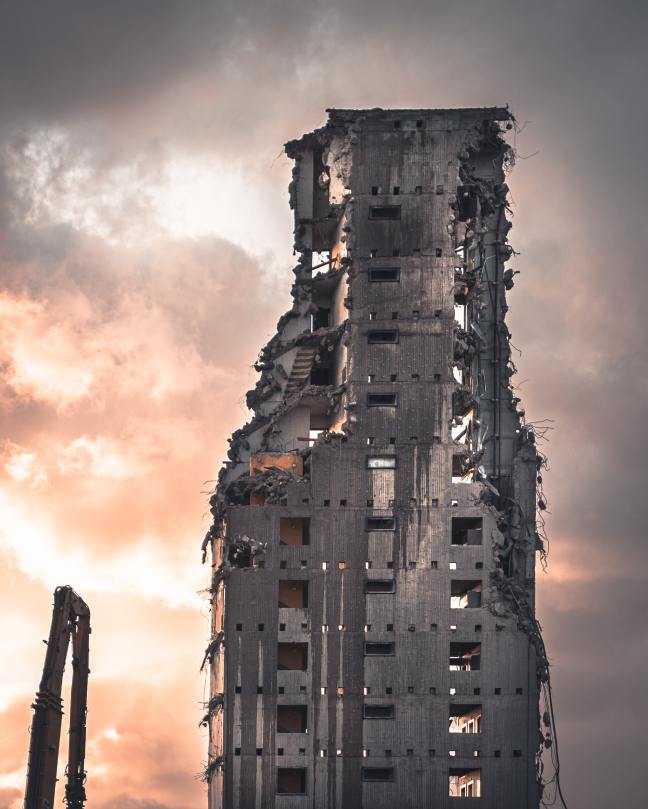The story of human civilization resembles that of a terminal patient. Shortly after the initial shock of diagnosis, the patient will always look for a way to process their grim new reality, so that they can function beyond grief and despair. There is a practical objective here, which is to establish some type of “normal” day-to-day existence, despite the surrealistically morbid prognosis. If achieved, this would be a triumph of mind over matter: the patient’s clinical picture may be fast deteriorating, but they have somehow found the strength to become firmly grounded in the present, so as to not be constantly preoccupied by their disease in every single waking moment of their remaining existence. By clinical standards, the terminal patients who have achieved this feat are often considered the heroes of palliative care, having crossed an important medical threshold. They have improved their morale, and quality of life as a result. Some of them in fact are finding themselves thriving, like never before in their lives, even as their health deteriorates.
Some are defiant enough to say no to drugs and choose a shortened lifespan with an almost certain terminal outcome, as opposed to a longer one which however involves the mental and physical pain of going through treatment, such as seriously debilitating chemotherapy side effects. Although the first option gives them significantly fewer, if any, chances of survival, it allows them to settle upfront for a current existence that is as normal as possible, however brief. It is an option that may find many critics, but it is the option that provides the most certainty and stability, which seem to be the key criteria for this specific patient. By choosing the no-treatment option, they have managed to normalize their daily existence.
Our civilization is no different. What tends to matter most to humans when faced with disaster is not so much how bad it will eventually get in the future, but how much it is affecting their day-to-day existence in the present. Like the terminal patient, we seek to normalize our day-to-day existence at any cost, even if this means accepting an apocalyptic reality as our “new normal” in the very near future. To do this, we are willing to shift our own definition of what constitutes a disaster in the first place: by seeing and processing disasters not through an objective review of evidence, but through a distorted lens of previous or even future disasters that we compare it to. Despite all the scientific magnitude scales, number of victims or other impartial evidence collected at the disaster site, our rescue response rarely ever reflects the real magnitude of the event, but our own perception of that magnitude instead. We prefer to process disaster through a distorted lens of previous or future disasters, as opposed to an objective review of facts. Once our perception of a disaster has been effectively normalized, we may as well not consider it a disaster. This is effectively how the patient that is our civilization is able to maintain its sense of normality during times of war and famine, and how it will undoubtedly continue to maintain its mental composure as the climate crisis deepens. The terminal patient already knows that the pills of cutting emissions are extremely bitter, and has been putting them off indefinitely.
There is a strong biological basis for our normalization behavior. Our quest for normalization of situations is a survival technique all organisms employ when faced with a changing environment. Our own bodies are actually made to regulate their reality. For example, our body can trick us into thinking that the outside temperature has not changed. We sweat when it is hot outside, therefore reducing our perception of feeling hot. This process takes place involuntarily i.e. we may not even notice it. Similarly, our rate and depth of breathing tends to automatically adjust to changes in air temperature, as well as small changes in the concentration of oxygen. Humans, as well as all other 8 million species on this planet, are equipped with countless chemical, metabolic and neural pathways that constantly assess our reality and regulate it accordingly, without us even knowing that this is happening. While the existence of these autonomic functions allows us to focus our energy on the more grey areas where active decision making is needed, it does make one question just how independent we think our brain is. Are there similar “normalization reflexes” in our brain? Do we inherently seek to normalize all disasters around us, whether through denial or other mental strategies?
Our constructs of authority and religion would support this argument, their objective always having been to exercise control on the population in order to normalize, minimize and therefore defuse, any situation which may threaten the status-quo. Government and religion are the autonomic bodily functions of civilization: constantly adjusting our perspective with us barely realizing it. In one of his iconic documentaries, Adam Curtis makes reference to “hypernormalization”: one of the key ingredients in the collective response from a system defending itself against change. It is more than just denial, or distortion of truth. It is about shifting the goal posts, and redefining what truth is. The result of hypernormalization couldn’t be more reassuring. The patient maintains their peace of mind, and continues their daily existence just as they did up to now:
“In the past 40 years Politicians, Financiers, and Technological Utopians, rather than face up to the real complexities of the world, retreated. Instead, they constructed a simpler version of the world, in order to hang on to power. And as this fake world grew, all of us went along with it. Because the simplicity was reassuring. Even those who thought they were attacking the system, the radicals, the artists, the musicians, and our whole counterculture, actually became part of the treachery. Because they too, had retreated into the make-believe world. Which is why their opposition has no effect, and nothing ever changes”.
Hypernormalization is a gradual, yet radical surrender to a situation which may be uncomfortable and threatening at first, yet becomes more palatable the more it integrates itself into the daily reality. Eventually, it becomes reality itself. It becomes normality, and it becomes accepted. Normalization today is not only an autonomic function of our nervous system. It is a method perpetrated by those who lead us in order to avert dissent against systems or policies which have failed. In response to the existential crisis the planet is facing, a series of muted “panic buttons” are being pushed: weak enough to fail to raise the alarm, yet loud enough to make us accustomed to the apocalyptic future we are swiftly entering. It is a delicate balance. The global collapse of industrial civilization will continue to be managed very effectively by half-truths, green hopium and invented villains. What will remain completely unmanageable, and out of control, is the climate, ecological apocalypse, and any future we may have hoped for.
In order for normalization to be successful, the subjects need to be kept distracted and saturated with activities, so that they have no time or mental space to question their reality, to even notice that anything around them is changing. Like a colony of ants that can’t look up, humans have become too busy, narcissistic and enslaved to their day-to-day reality to even question where this civilization is heading. And this is exactly what the CO2-emitting machine of capitalism wants. Any disaster or collapse is a direct threat to the bottom line of every corporation on this planet. Consumer messaging, political propaganda, religious sermons and the burning of witches are the marketing activities that the system will continue to use to say” : “DON’T WORRY, IT’S ALL OK”
Hypernormalization is also a strategy that leaders have used again and again at various points to subliminally coerce people into accepting “pretend solutions” (e.g. war) that would normally be highly uncomfortable and highly resisted. The suggested solution, however extreme initially, gains so much coverage and salience that it is eventually accepted by a key minority as a valid tenet within the wider conversation. As the debate continues, this extreme opinion eventually wins the favor of a majority who accepted it out of fear, presented to them as the “lesser evil” option.
The way hypernormalization works in practice is simple: repetition, repetition, repetition. In the UK, the campaign for the Brexit referendum similarly benefitted from a hypernormalization exercise by the far right, which eventually legitimized the Leave cause. All of a sudden, leaving Europe was a serious option. David Cameron himself became hypernormalized to it and called the referendum, which further legitimized the Leave movement by giving it a vote. As we come face to face with serious dilemmas, whether it is the adoption of geo-engineering or the mass deportation of climate immigrants, hypernormalization will be a key element in shifting public opinion to where leaders want it to be. Dangerous views like racism can be converted from crimes into valid opinions in the future, as recent events have demonstrated. Real events such as the climate crisis can be turned into debates instead. And terminal patients can be made to think they will live a long life, just as they are doing everything possible to accelerate their death.
George is an author, researcher, chemist, molecular biologist and food scientist. You can follow him on Twitter @99blackbaloons or enjoy his books

